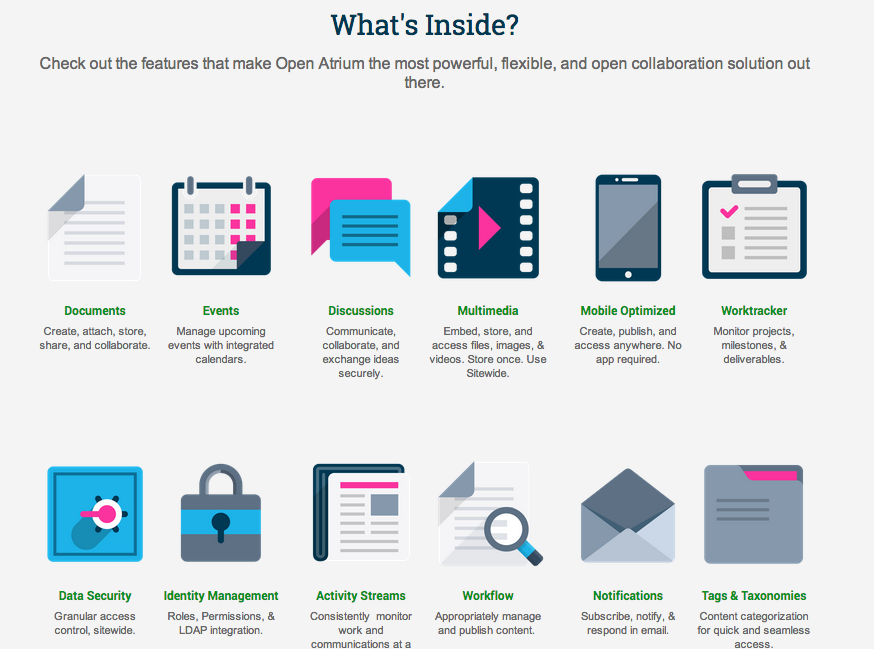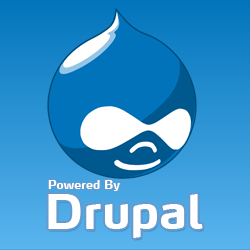I think the title of this post is damn right to the point isn’t it? We were using OpenAtrium 1 at work a year ago, but due to so many issues of having too many errors, memory leaks, and being just overly bloated, I decided to stop using it.
Fast forward to 2014: I started looking for a collaboration and project management tool again and decided to check on the development on OpenAtrium 2. It is based on Drupal 7 core which I thought was amazing. I downloaded and installed OpenAtrium 2 and it had a colour packed home page which looked attractive, but one that I quickly got annoyed with.
The OpenAtrium website now has a responsive design and is mobile friendly, but at what cost?
Who is OpenAtrium really for?
OpenAtrium is targeted towards web developers and architects, end users probably won’t be that interested and even if they won’t understand it because the software is complex and multi-dimensional. As you can see in the screenshot of OpenAtrium.com below, this is supposed to tell the viewer what is inside OpenAtrium. There are images and short descriptions for each component, but that is it. There is no link to get into technical details. Data Security for e.g. says Granular access control side wide – an architect would need to know how this is accomplished! How are Events managed, what is the workflow like in order to determine whether this piece of software is suitable for their organization or not.
Where is the Contact Page?
Wait! What? There is no Contact page. I’m forced to use twitter or Facebook? You’re kidding right?
Oh wait a minute, yes there is a link to the contact page on the FAQs page,oh…but it DOES NOT WORK! And mind you this is supposed to lead their customer’s to a page where they can contact their sales team! AMAZING!
Phase2 can offer custom enterprise platform development services, specific to the solution set Open Atrium offers. For more information and to contact our sales team, go here.
Where is the Documentation?
There is NO direct link from OpenAtrium.com to documentation! That’s right! You get to see OpenAtrium Documentation AFTER you download the software and install it. During Installation, I kept getting errors which were very crude MySQL errors which told me absolutely NOTHING. I finally figured it out by googling it.
Okay, seriously,… where is the Documentation?
A link on the Home Page(of the OpenAtrium installation) does take you to a page which kind of looks like a documentation page, but nah.. it really isn’t! It’s more like a prank! The Webinars are LONG and do not get to the point quickly! When you click the How To Guides, it’s empty! Phase2 probably need to read a “How To Guide” for writing “How To Guides”.
Oh but wait, they do have links to Spanish Documentation! You can’t even get the English version right! As the Linux philosophy goes:
Do One thing, do it right!
FAQs? – What are FAQs for?
The FAQs on the OpenAtrium site seem like sarcasm. The questions are ridiculously long and the answers are worse. For e.g.
Q. We’ve been trying to model what a Group, a Space, and a Team wold look like using existing metaphors and it’s been challenging to map from an OA 1.x perspective to an OA 2.x perspective. the access controls at the bottom of a node edit form are particularly confusing due to inconsistencies in terminology. The ones on the side bar look like they’ve been renamed appropriately. Could you provide some clarity?
Most of the questions seem like they might be coming from people working at Phase 2 (The company behind OpenAtrium).They should change the title of the page to “FAQs that our developers keep asking us”
Other Broken Things on OpenAtrium’s website:
- Credit’s link at the bottom of the page takes you to an empty box that says “Credits”
- Copyright details at the bottom of the page seems like it’s not updated.
- No Contact page
- No direct link to OpenAtrium Documentation
Finall conclusion: it almost seems like that Phase2 might actually have a good product, but they’ve made OpenAtrium.com and documentation very difficult to navigate and left chunks of it out which really just drives away the people that might actually be interested in using this product. UNLESS, that is their whole purpose, drive the developers away and target the endusers and managers that have little to no technical skills making it a really sneak sales technique and a kind of faking to be truly OpenSource. Or maybe they just have low standards!
I am angry, disappointed and feel deceived and betrayed by the people behind OpenAtrium.

 I have been working with the Drupal Content Management System for almost 2 years now. Here is a quick 5 minute small checklist of things that I look at before choosing a Drupal module for my Drupal Projects.
I have been working with the Drupal Content Management System for almost 2 years now. Here is a quick 5 minute small checklist of things that I look at before choosing a Drupal module for my Drupal Projects.
.png)
